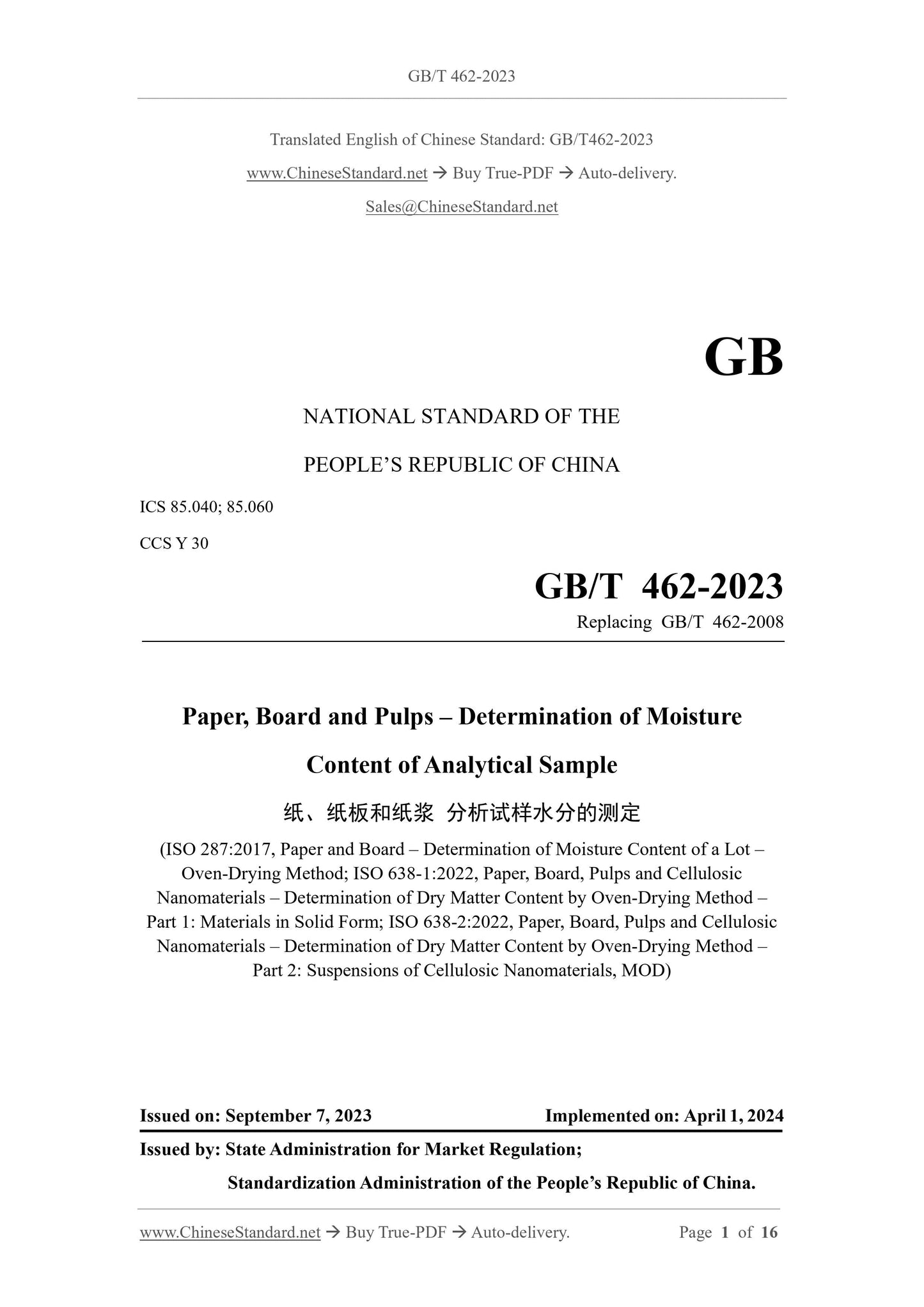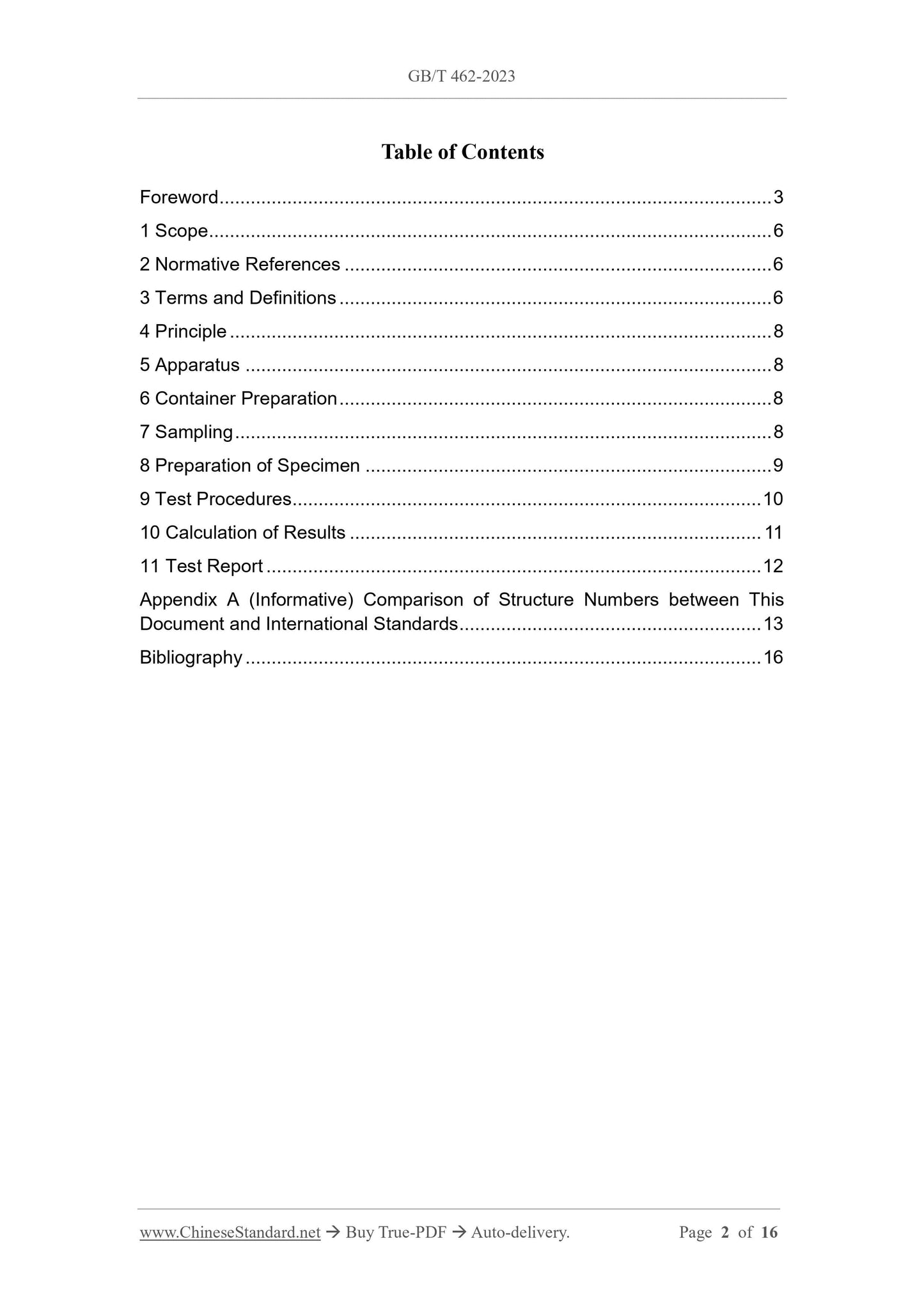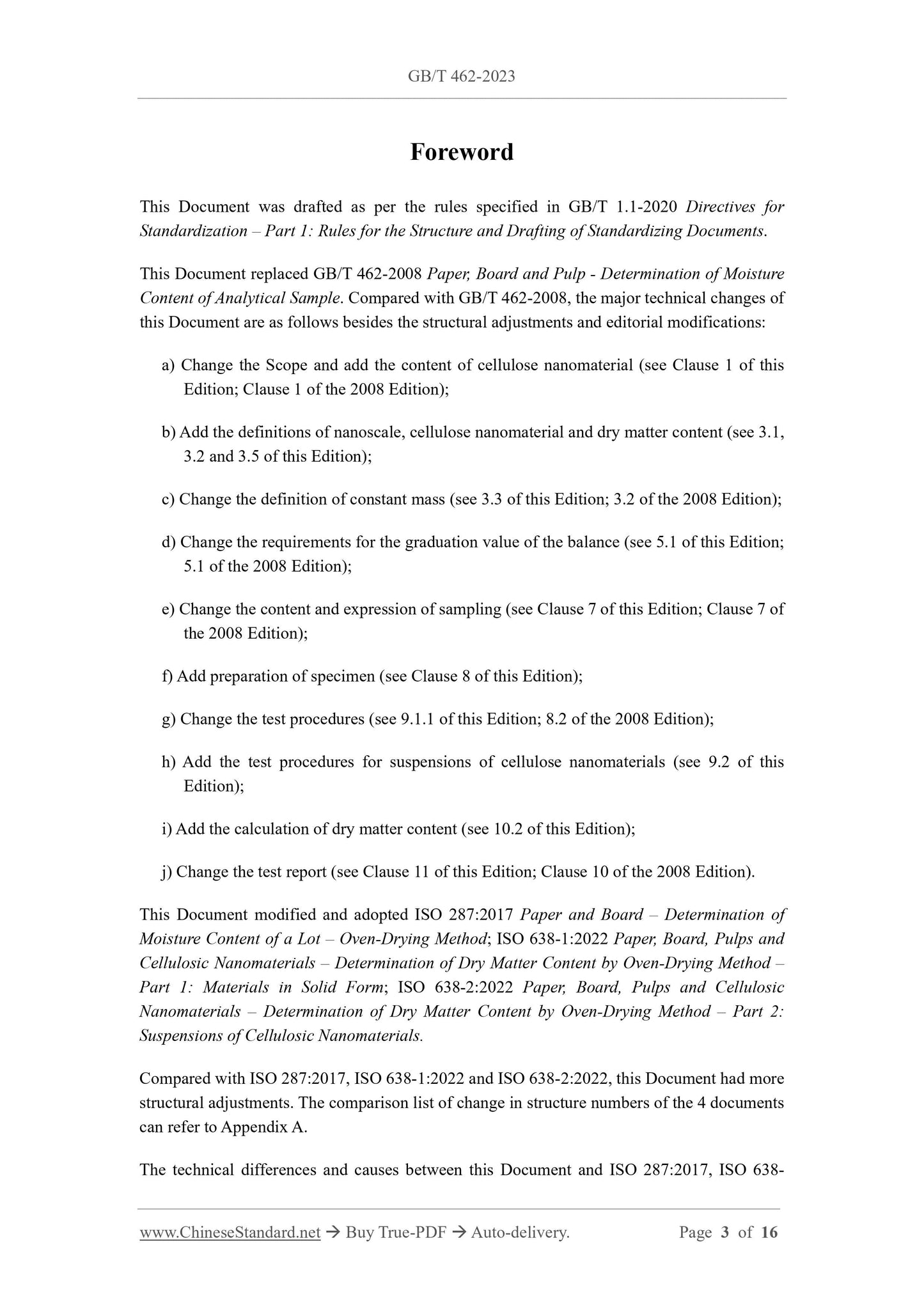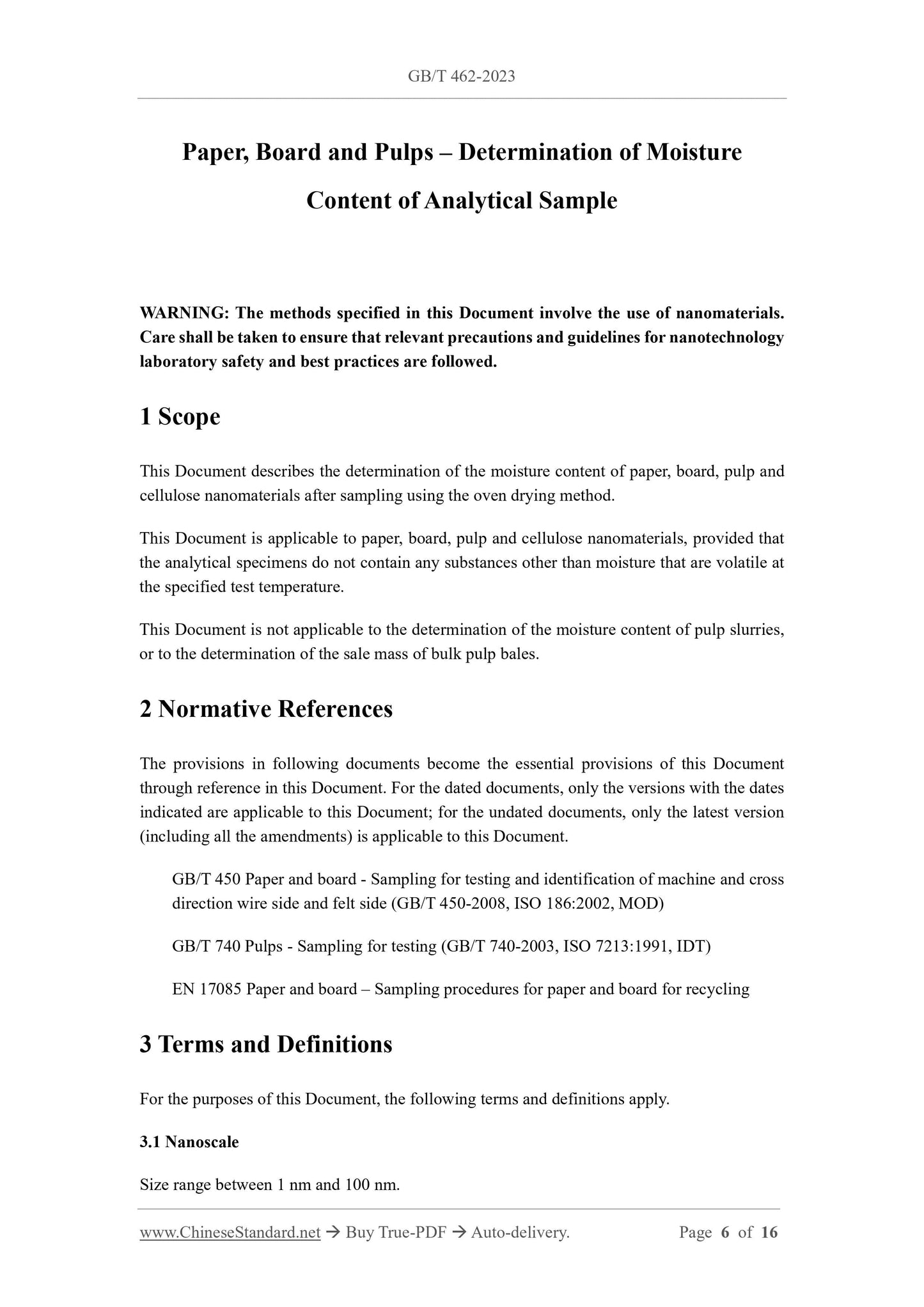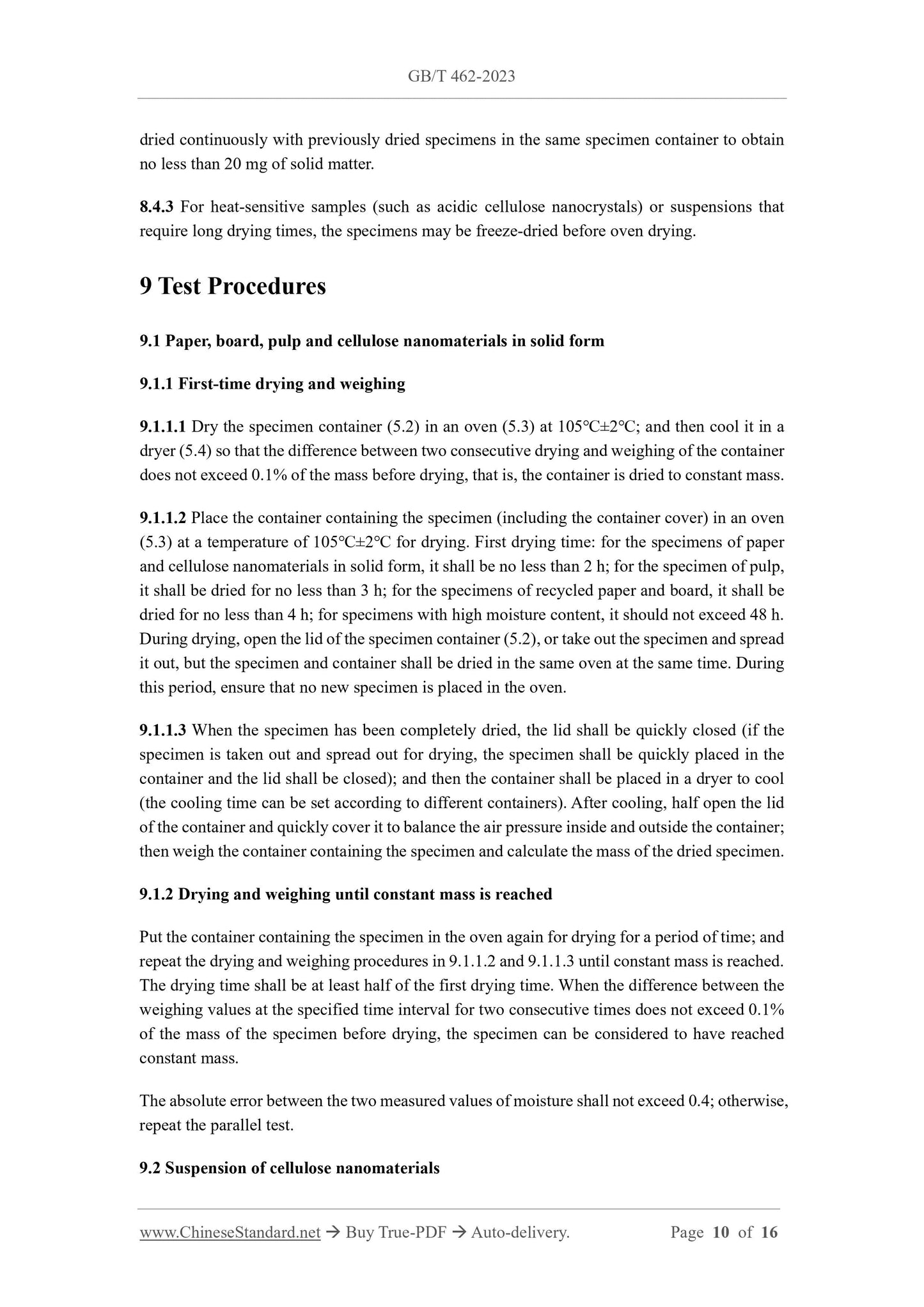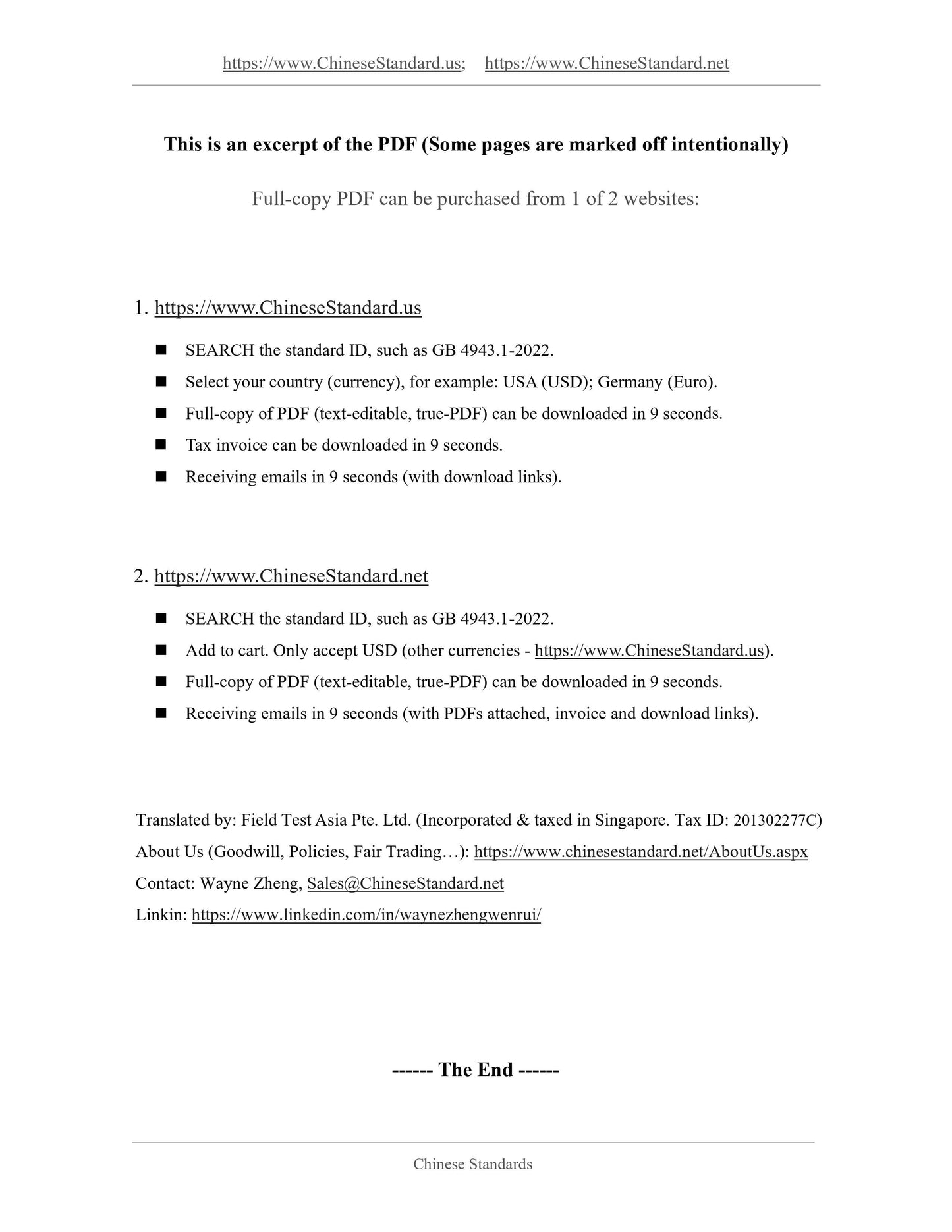1
/
of
6
www.ChineseStandard.us -- Field Test Asia Pte. Ltd.
GB/T 462-2023 English PDF (GB/T462-2023)
GB/T 462-2023 English PDF (GB/T462-2023)
Regular price
$245.00
Regular price
Sale price
$245.00
Unit price
/
per
Shipping calculated at checkout.
Couldn't load pickup availability
GB/T 462-2023: Paper, board and pulps - Determination of moisture content of analytical sample
Delivery: 9 seconds. Download (and Email) true-PDF + Invoice.
Get Quotation: Click GB/T 462-2023 (Self-service in 1-minute)
Historical versions (Master-website): GB/T 462-2023
Preview True-PDF (Reload/Scroll-down if blank)
GB/T 462-2023
GB
NATIONAL STANDARD OF THE
PEOPLE’S REPUBLIC OF CHINA
ICS 85.040; 85.060
CCS Y 30
Replacing GB/T 462-2008
Paper, Board and Pulps – Determination of Moisture
Content of Analytical Sample
(ISO 287:2017, Paper and Board – Determination of Moisture Content of a Lot –
Oven-Drying Method; ISO 638-1:2022, Paper, Board, Pulps and Cellulosic
Nanomaterials – Determination of Dry Matter Content by Oven-Drying Method –
Part 1: Materials in Solid Form; ISO 638-2:2022, Paper, Board, Pulps and Cellulosic
Nanomaterials – Determination of Dry Matter Content by Oven-Drying Method –
Part 2: Suspensions of Cellulosic Nanomaterials, MOD)
ISSUED ON: SEPTEMBER 7, 2023
IMPLEMENTED ON: APRIL 1, 2024
Issued by: State Administration for Market Regulation;
Standardization Administration of the People’s Republic of China.
Table of Contents
Foreword ... 3
1 Scope ... 6
2 Normative References ... 6
3 Terms and Definitions ... 6
4 Principle ... 8
5 Apparatus ... 8
6 Container Preparation ... 8
7 Sampling ... 8
8 Preparation of Specimen ... 9
9 Test Procedures ... 10
10 Calculation of Results ... 11
11 Test Report ... 12
Appendix A (Informative) Comparison of Structure Numbers between This
Document and International Standards ... 13
Bibliography ... 16
Foreword
This Document was drafted as per the rules specified in GB/T 1.1-2020 Directives for
Standardization – Part 1: Rules for the Structure and Drafting of Standardizing Documents.
This Document replaced GB/T 462-2008 Paper, Board and Pulp - Determination of Moisture
Content of Analytical Sample. Compared with GB/T 462-2008, the major technical changes of
this Document are as follows besides the structural adjustments and editorial modifications:
a) Change the Scope and add the content of cellulose nanomaterial (see Clause 1 of this
Edition; Clause 1 of the 2008 Edition);
b) Add the definitions of nanoscale, cellulose nanomaterial and dry matter content (see 3.1,
3.2 and 3.5 of this Edition);
c) Change the definition of constant mass (see 3.3 of this Edition; 3.2 of the 2008 Edition);
d) Change the requirements for the graduation value of the balance (see 5.1 of this Edition;
5.1 of the 2008 Edition);
e) Change the content and expression of sampling (see Clause 7 of this Edition; Clause 7 of
the 2008 Edition);
f) Add preparation of specimen (see Clause 8 of this Edition);
g) Change the test procedures (see 9.1.1 of this Edition; 8.2 of the 2008 Edition);
h) Add the test procedures for suspensions of cellulose nanomaterials (see 9.2 of this
Edition);
i) Add the calculation of dry matter content (see 10.2 of this Edition);
j) Change the test report (see Clause 11 of this Edition; Clause 10 of the 2008 Edition).
This Document modified and adopted ISO 287:2017 Paper and Board – Determination of
Moisture Content of a Lot – Oven-Drying Method; ISO 638-1:2022 Paper, Board, Pulps and
Cellulosic Nanomaterials – Determination of Dry Matter Content by Oven-Drying Method –
Part 1: Materials in Solid Form; ISO 638-2:2022 Paper, Board, Pulps and Cellulosic
Nanomaterials – Determination of Dry Matter Content by Oven-Drying Method – Part 2:
Suspensions of Cellulosic Nanomaterials.
Compared with ISO 287:2017, ISO 638-1:2022 and ISO 638-2:2022, this Document had more
structural adjustments. The comparison list of change in structure numbers of the 4 documents
can refer to Appendix A.
The technical differences and causes between this Document and ISO 287:2017, ISO 638-
Paper, Board and Pulps – Determination of Moisture
Content of Analytical Sample
WARNING: The methods specified in this Document involve the use of nanomaterials.
Care shall be taken to ensure that relevant precautions and guidelines for nanotechnology
laboratory safety and best practices are followed.
1 Scope
This Document describes the determination of the moisture content of paper, board, pulp and
cellulose nanomaterials after sampling using the oven drying method.
This Document is applicable to paper, board, pulp and cellulose nanomaterials, provided that
the analytical specimens do not contain any substances other than moisture that are volatile at
the specified test temperature.
This Document is not applicable to the determination of the moisture content of pulp slurries,
or to the determination of the sale mass of bulk pulp bales.
2 Normative References
The provisions in following documents become the essential provisions of this Document
through reference in this Document. For the dated documents, only the versions with the dates
indicated are applicable to this Document; for the undated documents, only the latest version
(including all the amendments) is applicable to this Document.
GB/T 450 Paper and board - Sampling for testing and identification of machine and cross
direction wire side and felt side (GB/T 450-2008, ISO 186:2002, MOD)
GB/T 740 Pulps - Sampling for testing (GB/T 740-2003, ISO 7213:1991, IDT)
EN 17085 Paper and board – Sampling procedures for paper and board for recycling
3 Terms and Definitions
For the purposes of this Document, the following terms and definitions apply.
3.1 Nanoscale
Size range between 1 nm and 100 nm.
dried continuously with previously dried specimens in the same specimen container to obtain
no less than 20 mg of solid matter.
8.4.3 For heat-sensitive samples (such as acidic cellulose nanocrystals) or suspensions that
require long drying times, the specimens may be freeze-dried before oven drying.
9 Test Procedures
9.1 Paper, board, pulp and cellulose nanomaterials in solid form
9.1.1 First-time drying and weighing
9.1.1.1 Dry the specimen container (5.2) in an oven (5.3) at 105℃±2℃; and then cool it in a
dryer (5.4) so that the difference between two consecutive drying and weighing of the container
does not exceed 0.1% of the mass before drying, that is, the container is dried to constant mass.
9.1.1.2 Place the container containing the specimen (including the container cover) in an oven
(5.3) at a temperature of 105℃±2℃ for drying. First drying time: for the specimens of paper
and cellulose nanomaterials in solid form, it shall be no less than 2 h; for the specimen of pulp,
it shall be dried for no less than 3 h; for the specimens of recycled paper and board, it shall be
dried for no less than 4 h; for specimens with high moisture content, it should not exceed 48 h.
During drying, open the lid of the specimen container (5.2), or take out the specimen and spread
it out, but the specimen and container shall be dried in the same oven at the same time. During
this period, ensure that no new specimen is placed in the oven.
9.1.1.3 When the specimen has been completely dried, the lid shall be quickly closed (if the
specimen is taken out and spread out for drying, the specimen shall be quickly placed in the
container and the lid shall be closed); and then the container shall be placed in a dryer to cool
(the cooling time can be set according to different containers). After cooling, half open the lid
of the container and quickly cover it to balance the air pressure inside and outside the container;
then weigh the container containing the specimen and calculate the mass of the dried specimen.
9.1.2 Drying and weighing until constant mass is reached
Put the container containing the specimen in the oven again for drying for a period of time; and
repeat the drying and weighing procedures in 9.1.1.2 and 9.1.1.3 until constant mass is reached.
The drying time shall be at least half of the first drying time. When the difference between the
weighing values at the specified time interval for two consecutive times does not exceed 0.1%
of the mass of the specimen before drying, the specimen can be considered to have reached
constant mass.
The absolute error between the two measured values of moisture shall not exceed 0.4; otherwise,
repeat the parallel test.
9.2 Suspension of cellulose nanomaterials
GB/T 462-2023
GB
NATIONAL STANDARD OF THE
PEOPLE’S REPUBLIC OF CHINA
ICS 85.040; 85.060
CCS Y 30
Replacing GB/T 462-2008
Paper, Board and Pulps – Determination of Moisture
Content of Analytical Sample
(ISO 287:2017, Paper and Board – Determination of Moisture Content of a Lot –
Oven-Drying Method; ISO 638-1:2022, Paper, Board, Pulps and Cellulosic
Nanomaterials – Determination of Dry Matter Content by Oven-Drying Method –
Part 1: Materials in Solid Form; ISO 638-2:2022, Paper, Board, Pulps and Cellulosic
Nanomaterials – Determination of Dry Matter Content by Oven-Drying Method –
Part 2: Suspensions of Cellulosic Nanomaterials, MOD)
ISSUED ON: SEPTEMBER 7, 2023
IMPLEMENTED ON: APRIL 1, 2024
Issued by: State Administration for Market Regulation;
Standardization Administration of the People’s Republic of China.
Table of Contents
Foreword ... 3
1 Scope ... 6
2 Normative References ... 6
3 Terms and Definitions ... 6
4 Principle ... 8
5 Apparatus ... 8
6 Container Preparation ... 8
7 Sampling ... 8
8 Preparation of Specimen ... 9
9 Test Procedures ... 10
10 Calculation of Results ... 11
11 Test Report ... 12
Appendix A (Informative) Comparison of Structure Numbers between This
Document and International Standards ... 13
Bibliography ... 16
Foreword
This Document was drafted as per the rules specified in GB/T 1.1-2020 Directives for
Standardization – Part 1: Rules for the Structure and Drafting of Standardizing Documents.
This Document replaced GB/T 462-2008 Paper, Board and Pulp - Determination of Moisture
Content of Analytical Sample. Compared with GB/T 462-2008, the major technical changes of
this Document are as follows besides the structural adjustments and editorial modifications:
a) Change the Scope and add the content of cellulose nanomaterial (see Clause 1 of this
Edition; Clause 1 of the 2008 Edition);
b) Add the definitions of nanoscale, cellulose nanomaterial and dry matter content (see 3.1,
3.2 and 3.5 of this Edition);
c) Change the definition of constant mass (see 3.3 of this Edition; 3.2 of the 2008 Edition);
d) Change the requirements for the graduation value of the balance (see 5.1 of this Edition;
5.1 of the 2008 Edition);
e) Change the content and expression of sampling (see Clause 7 of this Edition; Clause 7 of
the 2008 Edition);
f) Add preparation of specimen (see Clause 8 of this Edition);
g) Change the test procedures (see 9.1.1 of this Edition; 8.2 of the 2008 Edition);
h) Add the test procedures for suspensions of cellulose nanomaterials (see 9.2 of this
Edition);
i) Add the calculation of dry matter content (see 10.2 of this Edition);
j) Change the test report (see Clause 11 of this Edition; Clause 10 of the 2008 Edition).
This Document modified and adopted ISO 287:2017 Paper and Board – Determination of
Moisture Content of a Lot – Oven-Drying Method; ISO 638-1:2022 Paper, Board, Pulps and
Cellulosic Nanomaterials – Determination of Dry Matter Content by Oven-Drying Method –
Part 1: Materials in Solid Form; ISO 638-2:2022 Paper, Board, Pulps and Cellulosic
Nanomaterials – Determination of Dry Matter Content by Oven-Drying Method – Part 2:
Suspensions of Cellulosic Nanomaterials.
Compared with ISO 287:2017, ISO 638-1:2022 and ISO 638-2:2022, this Document had more
structural adjustments. The comparison list of change in structure numbers of the 4 documents
can refer to Appendix A.
The technical differences and causes between this Document and ISO 287:2017, ISO 638-
Paper, Board and Pulps – Determination of Moisture
Content of Analytical Sample
WARNING: The methods specified in this Document involve the use of nanomaterials.
Care shall be taken to ensure that relevant precautions and guidelines for nanotechnology
laboratory safety and best practices are followed.
1 Scope
This Document describes the determination of the moisture content of paper, board, pulp and
cellulose nanomaterials after sampling using the oven drying method.
This Document is applicable to paper, board, pulp and cellulose nanomaterials, provided that
the analytical specimens do not contain any substances other than moisture that are volatile at
the specified test temperature.
This Document is not applicable to the determination of the moisture content of pulp slurries,
or to the determination of the sale mass of bulk pulp bales.
2 Normative References
The provisions in following documents become the essential provisions of this Document
through reference in this Document. For the dated documents, only the versions with the dates
indicated are applicable to this Document; for the undated documents, only the latest version
(including all the amendments) is applicable to this Document.
GB/T 450 Paper and board - Sampling for testing and identification of machine and cross
direction wire side and felt side (GB/T 450-2008, ISO 186:2002, MOD)
GB/T 740 Pulps - Sampling for testing (GB/T 740-2003, ISO 7213:1991, IDT)
EN 17085 Paper and board – Sampling procedures for paper and board for recycling
3 Terms and Definitions
For the purposes of this Document, the following terms and definitions apply.
3.1 Nanoscale
Size range between 1 nm and 100 nm.
dried continuously with previously dried specimens in the same specimen container to obtain
no less than 20 mg of solid matter.
8.4.3 For heat-sensitive samples (such as acidic cellulose nanocrystals) or suspensions that
require long drying times, the specimens may be freeze-dried before oven drying.
9 Test Procedures
9.1 Paper, board, pulp and cellulose nanomaterials in solid form
9.1.1 First-time drying and weighing
9.1.1.1 Dry the specimen container (5.2) in an oven (5.3) at 105℃±2℃; and then cool it in a
dryer (5.4) so that the difference between two consecutive drying and weighing of the container
does not exceed 0.1% of the mass before drying, that is, the container is dried to constant mass.
9.1.1.2 Place the container containing the specimen (including the container cover) in an oven
(5.3) at a temperature of 105℃±2℃ for drying. First drying time: for the ...
Delivery: 9 seconds. Download (and Email) true-PDF + Invoice.
Get Quotation: Click GB/T 462-2023 (Self-service in 1-minute)
Historical versions (Master-website): GB/T 462-2023
Preview True-PDF (Reload/Scroll-down if blank)
GB/T 462-2023
GB
NATIONAL STANDARD OF THE
PEOPLE’S REPUBLIC OF CHINA
ICS 85.040; 85.060
CCS Y 30
Replacing GB/T 462-2008
Paper, Board and Pulps – Determination of Moisture
Content of Analytical Sample
(ISO 287:2017, Paper and Board – Determination of Moisture Content of a Lot –
Oven-Drying Method; ISO 638-1:2022, Paper, Board, Pulps and Cellulosic
Nanomaterials – Determination of Dry Matter Content by Oven-Drying Method –
Part 1: Materials in Solid Form; ISO 638-2:2022, Paper, Board, Pulps and Cellulosic
Nanomaterials – Determination of Dry Matter Content by Oven-Drying Method –
Part 2: Suspensions of Cellulosic Nanomaterials, MOD)
ISSUED ON: SEPTEMBER 7, 2023
IMPLEMENTED ON: APRIL 1, 2024
Issued by: State Administration for Market Regulation;
Standardization Administration of the People’s Republic of China.
Table of Contents
Foreword ... 3
1 Scope ... 6
2 Normative References ... 6
3 Terms and Definitions ... 6
4 Principle ... 8
5 Apparatus ... 8
6 Container Preparation ... 8
7 Sampling ... 8
8 Preparation of Specimen ... 9
9 Test Procedures ... 10
10 Calculation of Results ... 11
11 Test Report ... 12
Appendix A (Informative) Comparison of Structure Numbers between This
Document and International Standards ... 13
Bibliography ... 16
Foreword
This Document was drafted as per the rules specified in GB/T 1.1-2020 Directives for
Standardization – Part 1: Rules for the Structure and Drafting of Standardizing Documents.
This Document replaced GB/T 462-2008 Paper, Board and Pulp - Determination of Moisture
Content of Analytical Sample. Compared with GB/T 462-2008, the major technical changes of
this Document are as follows besides the structural adjustments and editorial modifications:
a) Change the Scope and add the content of cellulose nanomaterial (see Clause 1 of this
Edition; Clause 1 of the 2008 Edition);
b) Add the definitions of nanoscale, cellulose nanomaterial and dry matter content (see 3.1,
3.2 and 3.5 of this Edition);
c) Change the definition of constant mass (see 3.3 of this Edition; 3.2 of the 2008 Edition);
d) Change the requirements for the graduation value of the balance (see 5.1 of this Edition;
5.1 of the 2008 Edition);
e) Change the content and expression of sampling (see Clause 7 of this Edition; Clause 7 of
the 2008 Edition);
f) Add preparation of specimen (see Clause 8 of this Edition);
g) Change the test procedures (see 9.1.1 of this Edition; 8.2 of the 2008 Edition);
h) Add the test procedures for suspensions of cellulose nanomaterials (see 9.2 of this
Edition);
i) Add the calculation of dry matter content (see 10.2 of this Edition);
j) Change the test report (see Clause 11 of this Edition; Clause 10 of the 2008 Edition).
This Document modified and adopted ISO 287:2017 Paper and Board – Determination of
Moisture Content of a Lot – Oven-Drying Method; ISO 638-1:2022 Paper, Board, Pulps and
Cellulosic Nanomaterials – Determination of Dry Matter Content by Oven-Drying Method –
Part 1: Materials in Solid Form; ISO 638-2:2022 Paper, Board, Pulps and Cellulosic
Nanomaterials – Determination of Dry Matter Content by Oven-Drying Method – Part 2:
Suspensions of Cellulosic Nanomaterials.
Compared with ISO 287:2017, ISO 638-1:2022 and ISO 638-2:2022, this Document had more
structural adjustments. The comparison list of change in structure numbers of the 4 documents
can refer to Appendix A.
The technical differences and causes between this Document and ISO 287:2017, ISO 638-
Paper, Board and Pulps – Determination of Moisture
Content of Analytical Sample
WARNING: The methods specified in this Document involve the use of nanomaterials.
Care shall be taken to ensure that relevant precautions and guidelines for nanotechnology
laboratory safety and best practices are followed.
1 Scope
This Document describes the determination of the moisture content of paper, board, pulp and
cellulose nanomaterials after sampling using the oven drying method.
This Document is applicable to paper, board, pulp and cellulose nanomaterials, provided that
the analytical specimens do not contain any substances other than moisture that are volatile at
the specified test temperature.
This Document is not applicable to the determination of the moisture content of pulp slurries,
or to the determination of the sale mass of bulk pulp bales.
2 Normative References
The provisions in following documents become the essential provisions of this Document
through reference in this Document. For the dated documents, only the versions with the dates
indicated are applicable to this Document; for the undated documents, only the latest version
(including all the amendments) is applicable to this Document.
GB/T 450 Paper and board - Sampling for testing and identification of machine and cross
direction wire side and felt side (GB/T 450-2008, ISO 186:2002, MOD)
GB/T 740 Pulps - Sampling for testing (GB/T 740-2003, ISO 7213:1991, IDT)
EN 17085 Paper and board – Sampling procedures for paper and board for recycling
3 Terms and Definitions
For the purposes of this Document, the following terms and definitions apply.
3.1 Nanoscale
Size range between 1 nm and 100 nm.
dried continuously with previously dried specimens in the same specimen container to obtain
no less than 20 mg of solid matter.
8.4.3 For heat-sensitive samples (such as acidic cellulose nanocrystals) or suspensions that
require long drying times, the specimens may be freeze-dried before oven drying.
9 Test Procedures
9.1 Paper, board, pulp and cellulose nanomaterials in solid form
9.1.1 First-time drying and weighing
9.1.1.1 Dry the specimen container (5.2) in an oven (5.3) at 105℃±2℃; and then cool it in a
dryer (5.4) so that the difference between two consecutive drying and weighing of the container
does not exceed 0.1% of the mass before drying, that is, the container is dried to constant mass.
9.1.1.2 Place the container containing the specimen (including the container cover) in an oven
(5.3) at a temperature of 105℃±2℃ for drying. First drying time: for the specimens of paper
and cellulose nanomaterials in solid form, it shall be no less than 2 h; for the specimen of pulp,
it shall be dried for no less than 3 h; for the specimens of recycled paper and board, it shall be
dried for no less than 4 h; for specimens with high moisture content, it should not exceed 48 h.
During drying, open the lid of the specimen container (5.2), or take out the specimen and spread
it out, but the specimen and container shall be dried in the same oven at the same time. During
this period, ensure that no new specimen is placed in the oven.
9.1.1.3 When the specimen has been completely dried, the lid shall be quickly closed (if the
specimen is taken out and spread out for drying, the specimen shall be quickly placed in the
container and the lid shall be closed); and then the container shall be placed in a dryer to cool
(the cooling time can be set according to different containers). After cooling, half open the lid
of the container and quickly cover it to balance the air pressure inside and outside the container;
then weigh the container containing the specimen and calculate the mass of the dried specimen.
9.1.2 Drying and weighing until constant mass is reached
Put the container containing the specimen in the oven again for drying for a period of time; and
repeat the drying and weighing procedures in 9.1.1.2 and 9.1.1.3 until constant mass is reached.
The drying time shall be at least half of the first drying time. When the difference between the
weighing values at the specified time interval for two consecutive times does not exceed 0.1%
of the mass of the specimen before drying, the specimen can be considered to have reached
constant mass.
The absolute error between the two measured values of moisture shall not exceed 0.4; otherwise,
repeat the parallel test.
9.2 Suspension of cellulose nanomaterials
GB/T 462-2023
GB
NATIONAL STANDARD OF THE
PEOPLE’S REPUBLIC OF CHINA
ICS 85.040; 85.060
CCS Y 30
Replacing GB/T 462-2008
Paper, Board and Pulps – Determination of Moisture
Content of Analytical Sample
(ISO 287:2017, Paper and Board – Determination of Moisture Content of a Lot –
Oven-Drying Method; ISO 638-1:2022, Paper, Board, Pulps and Cellulosic
Nanomaterials – Determination of Dry Matter Content by Oven-Drying Method –
Part 1: Materials in Solid Form; ISO 638-2:2022, Paper, Board, Pulps and Cellulosic
Nanomaterials – Determination of Dry Matter Content by Oven-Drying Method –
Part 2: Suspensions of Cellulosic Nanomaterials, MOD)
ISSUED ON: SEPTEMBER 7, 2023
IMPLEMENTED ON: APRIL 1, 2024
Issued by: State Administration for Market Regulation;
Standardization Administration of the People’s Republic of China.
Table of Contents
Foreword ... 3
1 Scope ... 6
2 Normative References ... 6
3 Terms and Definitions ... 6
4 Principle ... 8
5 Apparatus ... 8
6 Container Preparation ... 8
7 Sampling ... 8
8 Preparation of Specimen ... 9
9 Test Procedures ... 10
10 Calculation of Results ... 11
11 Test Report ... 12
Appendix A (Informative) Comparison of Structure Numbers between This
Document and International Standards ... 13
Bibliography ... 16
Foreword
This Document was drafted as per the rules specified in GB/T 1.1-2020 Directives for
Standardization – Part 1: Rules for the Structure and Drafting of Standardizing Documents.
This Document replaced GB/T 462-2008 Paper, Board and Pulp - Determination of Moisture
Content of Analytical Sample. Compared with GB/T 462-2008, the major technical changes of
this Document are as follows besides the structural adjustments and editorial modifications:
a) Change the Scope and add the content of cellulose nanomaterial (see Clause 1 of this
Edition; Clause 1 of the 2008 Edition);
b) Add the definitions of nanoscale, cellulose nanomaterial and dry matter content (see 3.1,
3.2 and 3.5 of this Edition);
c) Change the definition of constant mass (see 3.3 of this Edition; 3.2 of the 2008 Edition);
d) Change the requirements for the graduation value of the balance (see 5.1 of this Edition;
5.1 of the 2008 Edition);
e) Change the content and expression of sampling (see Clause 7 of this Edition; Clause 7 of
the 2008 Edition);
f) Add preparation of specimen (see Clause 8 of this Edition);
g) Change the test procedures (see 9.1.1 of this Edition; 8.2 of the 2008 Edition);
h) Add the test procedures for suspensions of cellulose nanomaterials (see 9.2 of this
Edition);
i) Add the calculation of dry matter content (see 10.2 of this Edition);
j) Change the test report (see Clause 11 of this Edition; Clause 10 of the 2008 Edition).
This Document modified and adopted ISO 287:2017 Paper and Board – Determination of
Moisture Content of a Lot – Oven-Drying Method; ISO 638-1:2022 Paper, Board, Pulps and
Cellulosic Nanomaterials – Determination of Dry Matter Content by Oven-Drying Method –
Part 1: Materials in Solid Form; ISO 638-2:2022 Paper, Board, Pulps and Cellulosic
Nanomaterials – Determination of Dry Matter Content by Oven-Drying Method – Part 2:
Suspensions of Cellulosic Nanomaterials.
Compared with ISO 287:2017, ISO 638-1:2022 and ISO 638-2:2022, this Document had more
structural adjustments. The comparison list of change in structure numbers of the 4 documents
can refer to Appendix A.
The technical differences and causes between this Document and ISO 287:2017, ISO 638-
Paper, Board and Pulps – Determination of Moisture
Content of Analytical Sample
WARNING: The methods specified in this Document involve the use of nanomaterials.
Care shall be taken to ensure that relevant precautions and guidelines for nanotechnology
laboratory safety and best practices are followed.
1 Scope
This Document describes the determination of the moisture content of paper, board, pulp and
cellulose nanomaterials after sampling using the oven drying method.
This Document is applicable to paper, board, pulp and cellulose nanomaterials, provided that
the analytical specimens do not contain any substances other than moisture that are volatile at
the specified test temperature.
This Document is not applicable to the determination of the moisture content of pulp slurries,
or to the determination of the sale mass of bulk pulp bales.
2 Normative References
The provisions in following documents become the essential provisions of this Document
through reference in this Document. For the dated documents, only the versions with the dates
indicated are applicable to this Document; for the undated documents, only the latest version
(including all the amendments) is applicable to this Document.
GB/T 450 Paper and board - Sampling for testing and identification of machine and cross
direction wire side and felt side (GB/T 450-2008, ISO 186:2002, MOD)
GB/T 740 Pulps - Sampling for testing (GB/T 740-2003, ISO 7213:1991, IDT)
EN 17085 Paper and board – Sampling procedures for paper and board for recycling
3 Terms and Definitions
For the purposes of this Document, the following terms and definitions apply.
3.1 Nanoscale
Size range between 1 nm and 100 nm.
dried continuously with previously dried specimens in the same specimen container to obtain
no less than 20 mg of solid matter.
8.4.3 For heat-sensitive samples (such as acidic cellulose nanocrystals) or suspensions that
require long drying times, the specimens may be freeze-dried before oven drying.
9 Test Procedures
9.1 Paper, board, pulp and cellulose nanomaterials in solid form
9.1.1 First-time drying and weighing
9.1.1.1 Dry the specimen container (5.2) in an oven (5.3) at 105℃±2℃; and then cool it in a
dryer (5.4) so that the difference between two consecutive drying and weighing of the container
does not exceed 0.1% of the mass before drying, that is, the container is dried to constant mass.
9.1.1.2 Place the container containing the specimen (including the container cover) in an oven
(5.3) at a temperature of 105℃±2℃ for drying. First drying time: for the ...
Share
